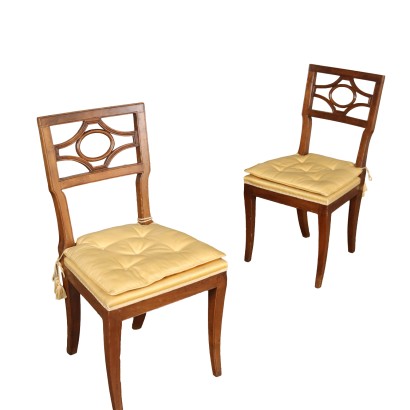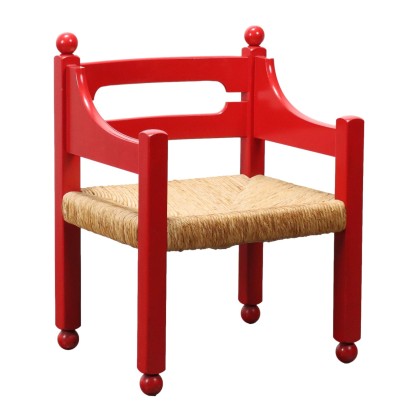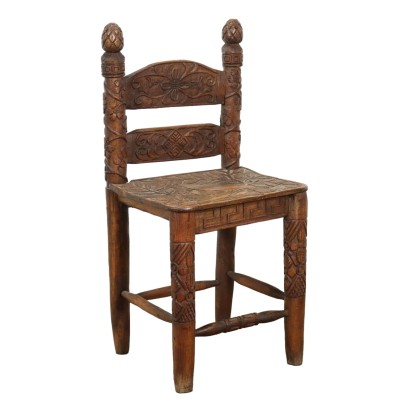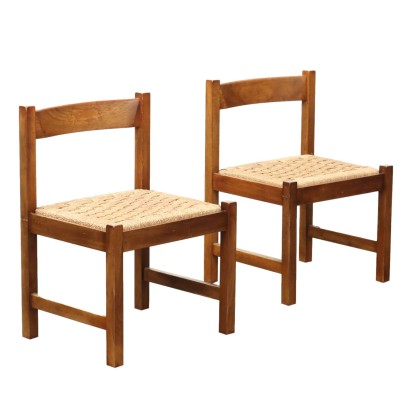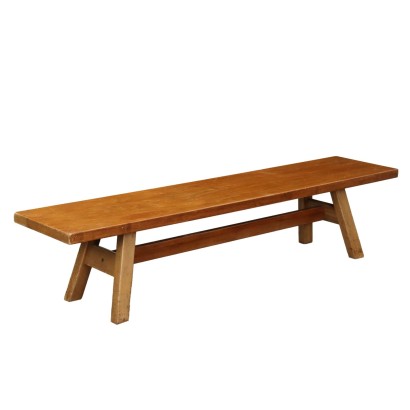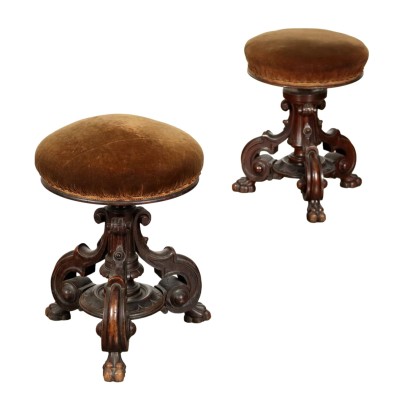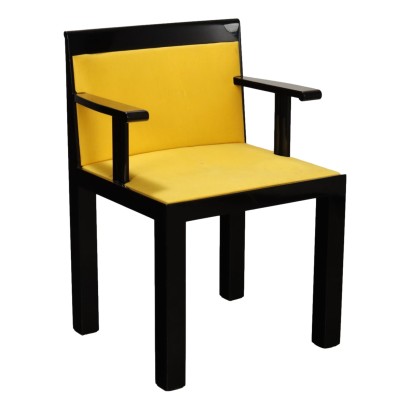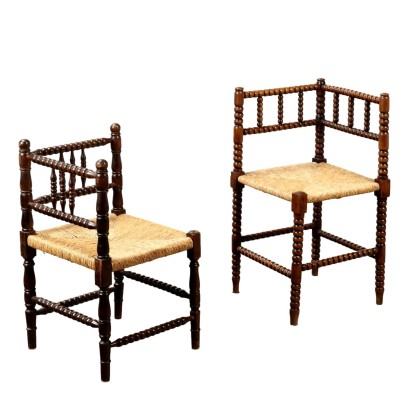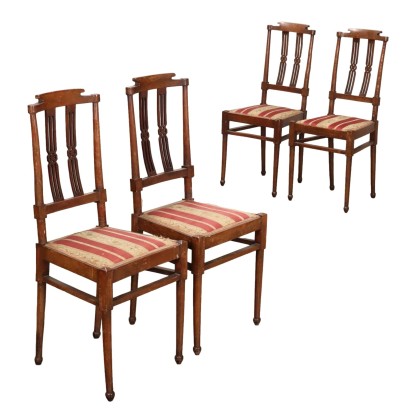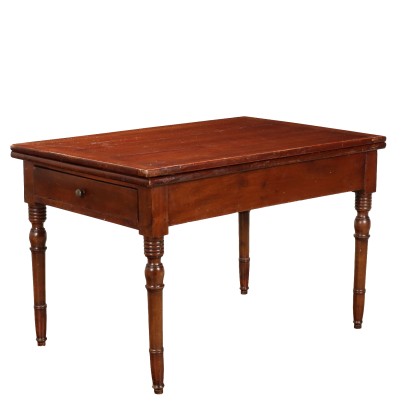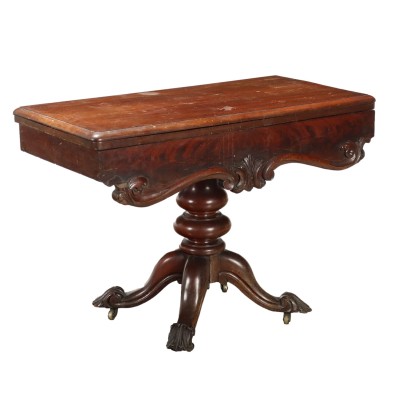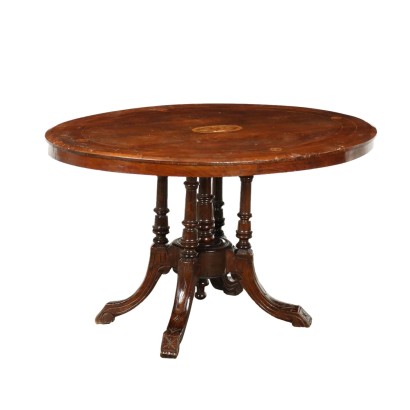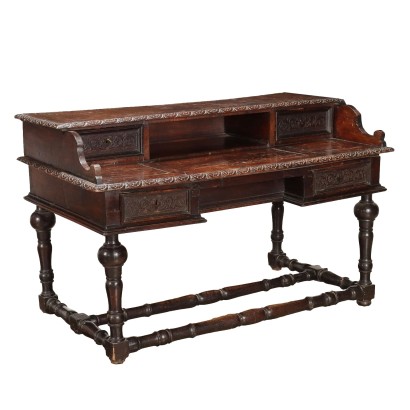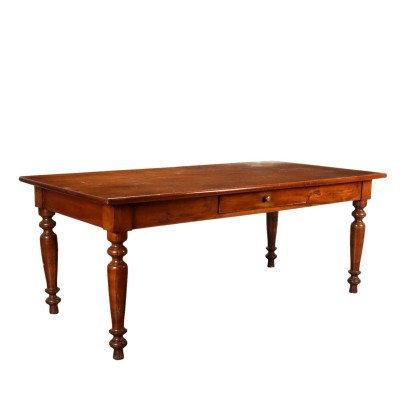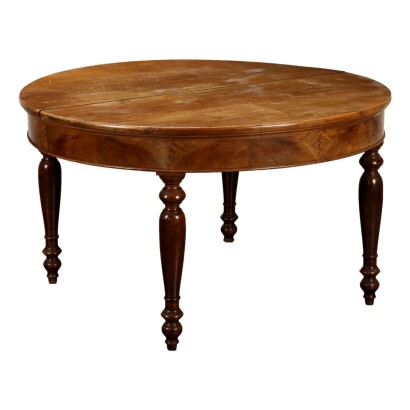Pair of Antique Directoire Armchairs Walnut Italy XVIII-XIX Century - Lombardy, Late XVIII - Early XIX Century
Features
Lombardy, Late XVIII - Early XIX Century
Style: Directoire (1790-1804)
Age: 19th Century / 1801 - 1900 , 18th Century / 1701 - 1800
Origin: Lombardia, Italy
Main essence: Walnut
Material: Padded , Carved Wood
Description
Pair of walnut directoirechairs, Lombardy, late 18th - early 19th century. Open back decorated with a geometric pattern, saber legs. Padded seats equipped with removable cushion.
Product Condition:
Product which due to age and wear requires restoration and re-polishing. We try to present the real state of the furniture as completely as possible with photos. If some details are not clear from the photos, what is stated in the description applies.
Dimensions (cm):
Height: 90
Width: 46,5
Depth: 48
Seat height: 45
Additional Information
Style: Directoire (1790-1804)
In this short period of time, we see, in the furniture, an accentuation of the archaeological rigor and at the same time an accentuated linear severity is formulated that in fact preludes and anticipates forms and ornamentations that will then be typical of the Empire style.The furniture of the Directoire era abandons the delicate pastel colors that characterize the Louis XVI production in favor of the dark magnificence of mahogany, which in its vast range of essences will be by far the most appreciated wood in this period.
Added to this is a general abandonment of the floral inlay trends in favor of simple fillets in ebony or amaranth-colored wood, the insertion of light linear profiles in brass is very fashionable.
The innovations are grafted onto a trend that normally finds typologies already widespread in the neoclassical era, and in some cases there is no lack of significant innovations: the chairs, often painted in light colors and archaeological motifs, are distinguished by the typical upholstered or openwork backrest that rolls up "en crosse" and in an "S".
The back legs are very fashionable if curved like a sabre and the typology with an enveloping backrest, called gondola, becomes widespread.
For studies and libraries, chair models characterized by a high concave backrest, called "en hémicycle", with a usually solid structure and a seat covered in leather, become widespread.
The use of the secrétaire finds wide diffusion and the typology of the toilette is completely new, now similar to a console on which a tilting mirror rests within hinged plates.
Certainly the most imaginative novelty of this period is the graceful psyche, consisting of a large oval or rectangular mirror, mounted within high wooden supports and generally supported by sabre-shaped legs.
This is the era in which the oval or round dining table became widely used, while the desk continued to maintain the shape of the à bureau plats models already known in the previous era.
In this period there were no particular technical-constructive innovations, the technologies remained those already in use since the beginning of the mid-eighteenth century.
Find out more about the Directory with our insights:
The unknown gaming table
INSERT ADDITIONAL LINKS:
The Austrian taste of Baroque
The furniture of the Kingdom of Naples
The end of the Directory and the beginning of the Empire
The birth of the private library
Age:
19th Century / 1801 - 1900
19th Century / 1801 - 190018th Century / 1701 - 1800
18th Century / 1701 - 1800Main essence: Walnut
Walnut wood comes from the plant whose botanical name is juglans regia , probably originally from the East but very common in Europe. Light or dark brown in color, it is a hard wood with a beautiful grain, widely used in antique furniture. It was the main essence in Italy throughout the Renaissance and later had a good diffusion in Europe, especially in England, until the advent of mahogany. It was used for solid wood furniture and sometimes carvings and inlays, its only big limitation is that it suffers a lot from woodworm. In France it was widely used more than anything else in the provinces. In the second half of the eighteenth century its use decreased significantly because mahogany and other exotic woods were preferred.Material:
Padded
Carved Wood
Other customers have searched:
Sedie, sedia antica, sedia ufficio, sgabello..
Per scoprire tutto su sedie antiche e di design, consulta il nostro blog e le presentazioni su FineArt:
Leggi di più
Breve storia della sedia, dall'Antico Egitto alla produzione in serie
Coppia di sgabelli, Roma XVII secolo
Coppia sedie barocchetto, Venezia
Sedie anni '50, Manifattura Italiana
Due sedie 'Ninfea' Gio Ponti da collezione
Due sedie 'Ninfea', Gio Ponti per F.lli Reguitti
Sull'antiquariato in generale dai un'occhiata anche a:
Classic Monday: da un pezzo dei nostri magazzini alla storia dell'antiquariato
L'antiquariato dalla A alla Z: il Dizionario dell'Antiquariato
Il dizionario dell'antiquariato - Lastronatura
Il dizionario dell'antiquariato - Mascherone
Il dizionario dell'antiquariato - Natura morta
Il dizionario dell'antiquariato - Opificio
Il dizionario dell'antiquariato - Pastiglia
Il dizionario dell'antiquariato - Savonarola
Il dizionario dell'antiquariato - Rosone
Leggi di più
Breve storia della sedia, dall'Antico Egitto alla produzione in serieCoppia di sgabelli, Roma XVII secolo
Coppia sedie barocchetto, Venezia
Sedie anni '50, Manifattura Italiana
Due sedie 'Ninfea' Gio Ponti da collezione
Due sedie 'Ninfea', Gio Ponti per F.lli Reguitti
Sull'antiquariato in generale dai un'occhiata anche a:
Classic Monday: da un pezzo dei nostri magazzini alla storia dell'antiquariato
L'antiquariato dalla A alla Z: il Dizionario dell'Antiquariato
Il dizionario dell'antiquariato - Lastronatura
Il dizionario dell'antiquariato - Mascherone
Il dizionario dell'antiquariato - Natura morta
Il dizionario dell'antiquariato - Opificio
Il dizionario dell'antiquariato - Pastiglia
Il dizionario dell'antiquariato - Savonarola
Il dizionario dell'antiquariato - Rosone
Product availability
The product can be seen at Cambiago
Immediate availability
Ready for delivery within 2 working days from ordering the product.



